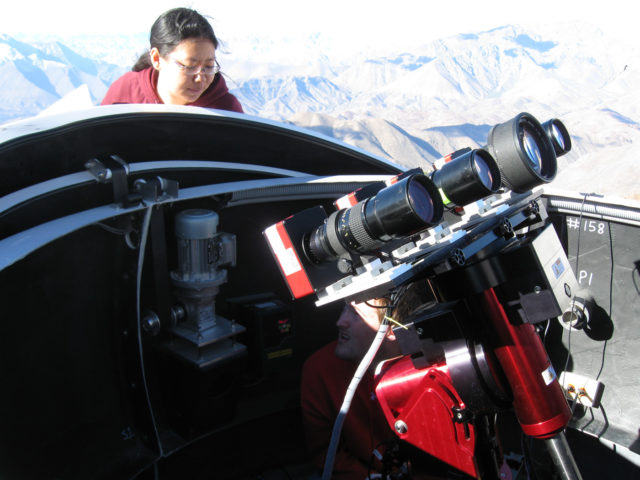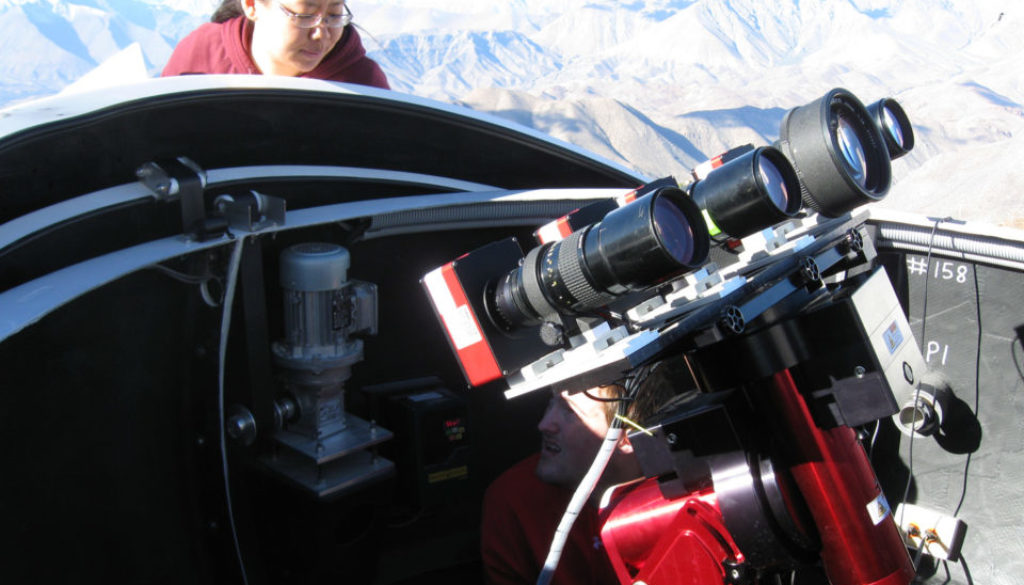Q&A with Graduate Student Ting Li ’16
In celebration of Student Research Week (March 23-27) at Texas A&M University, the College of Science will be taking five with five different people involved in various aspects and stages of research at Texas A&M and beyond. Today’s kickoff segment features Ting Li, a Ph.D. candidate in the Department of Physics and Astronomy and a member of the Charles R. ’62 and Judith G. Munnerlyn Astronomical Laboratory.
Among other accomplishments, Li recently built her own telescope, the Atmospheric Transmission Monitoring Camera (aTmCam), which currently is taking data in Chile that is being used for the five-year, Department of Energy-funded Dark Energy Survey. In addition, she is one of six graduate students worldwide to earn the coveted DES Builder status, which entitles her to be listed as an author on every DES collaboration-related paper released.
How did you end up at Texas A&M University and in the Munnerlyn Laboratory?
“I like the beautiful night sky and want to know how the stars and galaxies are formed and why they exist. When I was an undergraduate student, I knew I wanted to pursue a career in astronomy. Major advances in our understanding of the universe have often arisen from dramatic improvements of the observing techniques. Therefore, I wanted to be an astronomer as well as an instrument builder.


“When I applied for graduate school, I knew Texas A&M University had a fast-growing astronomy program in the Department of Physics and Astronomy. The number of astronomy faculty increased from three to seven from 2006 to 2008 and was still going up. A&M is also involved in many future large astronomical projects, such as the Dark Energy Survey, the Hobby-Eberly Telescope Dark Energy Experiment, the Giant Magellan Telescope, etc. Most importantly, Dr. Darren DePoy is leading the Astronomical Instrumentation Lab (i.e., Munnerlyn Lab) and building the state-of-the-art instruments for these projects. So I applied to the graduate program at Texas A&M, and once I was accepted, I decided I only wanted to work with Dr. DePoy. I’m happy that my willingness found me a spot in this lab and that I am contributing to many world-class astronomical projects.”
Describe a typical day/week in the lab.
“It’s hard to say what’s a typical day in the lab, as you never know where the research will take you. For example, sometimes, I spend time in the main lab area to help with assembly of the spectrographs we build; sometimes, I stay in the dark room all day and work with the optics on the optical bench. But most of the time, I stay in my office and work with computers. I spend most of that time analyzing data that I get from different observatories, including some from the instruments we built or are building in our lab. I also go to the Texas A&M Observatory very often during the night to test our newly developed instrumentation. Last but not least, I discuss my work with scientists, engineers and students inside the lab as well as with other worldwide collaborators via telephone conferences.”
What’s it like, working as a member of such a diverse group that features every level from undergraduate to postdoc and, individually and as a team, on such high-stakes, multi-million-dollar projects that span the gamut of and are outright game-changers for fundamental astrophysics?
“I like to work in such a diverse group, and that’s why I choose to work on building instruments for astronomy. As an instrument builder, you need to know about the science in different astronomical fields, and you also need to be able to communicate with engineers. This makes me feel like there are lots of things that are unknown to me, but also at the same time, I’m learning new things every day, and I’m happy with that.
“Our lab has lots of undergrads, graduate students, engineers and scientists. Dr. DePoy and Dr. Jennifer Marshall manage the lab in such a way that everyone is highly independent but also available to help each other when needed. Every week during our group meeting, we each present our work from the past week and our plans for next week and get feedback from our advisors. In any given week, all group members know what everyone is working on and get opportunities to learn things from each others’ projects.
“Furthermore, because a lot of these projects require effort from many people, I get the chance to work with undergrads as well as the engineers in our lab. As a member of the Munnerlyn Lab, I feel I’m learning things every day, and also I’m contributing what I’ve learned to this lab and to new instruments and new techniques that will improve our understanding of the universe.”
Proudest moment thus far in your research career? How about biggest surprise?
“I think the proudest moment in my graduate career is building aTmCam, the Atmospheric Transmission Monitoring Camera for the Dark Energy Survey. It has a robotic telescope with four scientific cameras. It was less than two months between the time DES decided to build the aTmCam and the time it started taking its first exposures. We did lots of preparation before we actually got funded, but still, it was amazing to make a system fully autonomously operational in such a short time period.
“I remember that when I went to the AAS (American Astronomical Society) meeting for the first time, I heard a talk about a robotic telescope. The speaker controlled his telescope remotely while he was giving the talk, and I felt it was so cool that he could do that. Now, I’m proud of myself because I can do the same thing for aTmCam, which is located at one of the best astronomical sites in the world. I also show how I can control the system remotely from my office to visitors sometimes. While this instrument was built for the Dark Energy Survey project, it also can benefit many other astronomical fields. After we built this instrument, some research groups showed interest in aTmCam, which is a big surprise to me.”
What would you tell others who are might be considering going to graduate school and pursuing a career in scientific research?
“I would say that graduate school is tough, so make sure that’s what you want before you decide to go that route. If you decide to take it, then enjoy it. Graduate school is much more independent, compared to the undergraduate program. Instead of professors telling you what to do in your undergraduate study, you are the one who needs to make the decisions about yourself most of the time. You also have to learn a lot of new things by yourself and solve the problems by yourself. So make sure you pick a field that you like and you are interested in.
“The difficulties can sometimes be incredibly frustrating. However, part of getting closer to becoming a qualified Ph.D. is dealing with setbacks and experiencing failure. Maybe you don’t feel that you are gaining new knowledge every day, or maybe you feel that you are standing still after many days of hard work. But after several months or even years, you will know that you have already made a huge improvement in your research ability. You won’t see the changes every day, but be patient and persistent, and you will succeed.”
Click here to read a related blog post offering insight into group dynamics within the Munnerlyn Astronomical Instrumentation Lab.
# # # # # # # # # #
Now in its 18th year, Student Research Week is a friendly competition that highlights both undergraduate and graduate research at Texas A&M, one of the country’s top research universities. The weeklong celebration fosters an environment for students, faculty and administrators to learn about student research at Texas A&M and also gives students an opportunity to win numerous awards and cash prizes. To learn more about the week’s schedule and specific events, go to http://srw.tamu.edu/.
For more information on graduate programs and related research opportunities in the College of Science, go to https://science.tamu.edu/admissions/graduate/.
-aTm-
Contact: Shana K. Hutchins, (979) 862-1237 or shutchins@science.tamu.edu
The post Q&A with Graduate Student Ting Li ’16 appeared first on Texas A&M College of Science.
